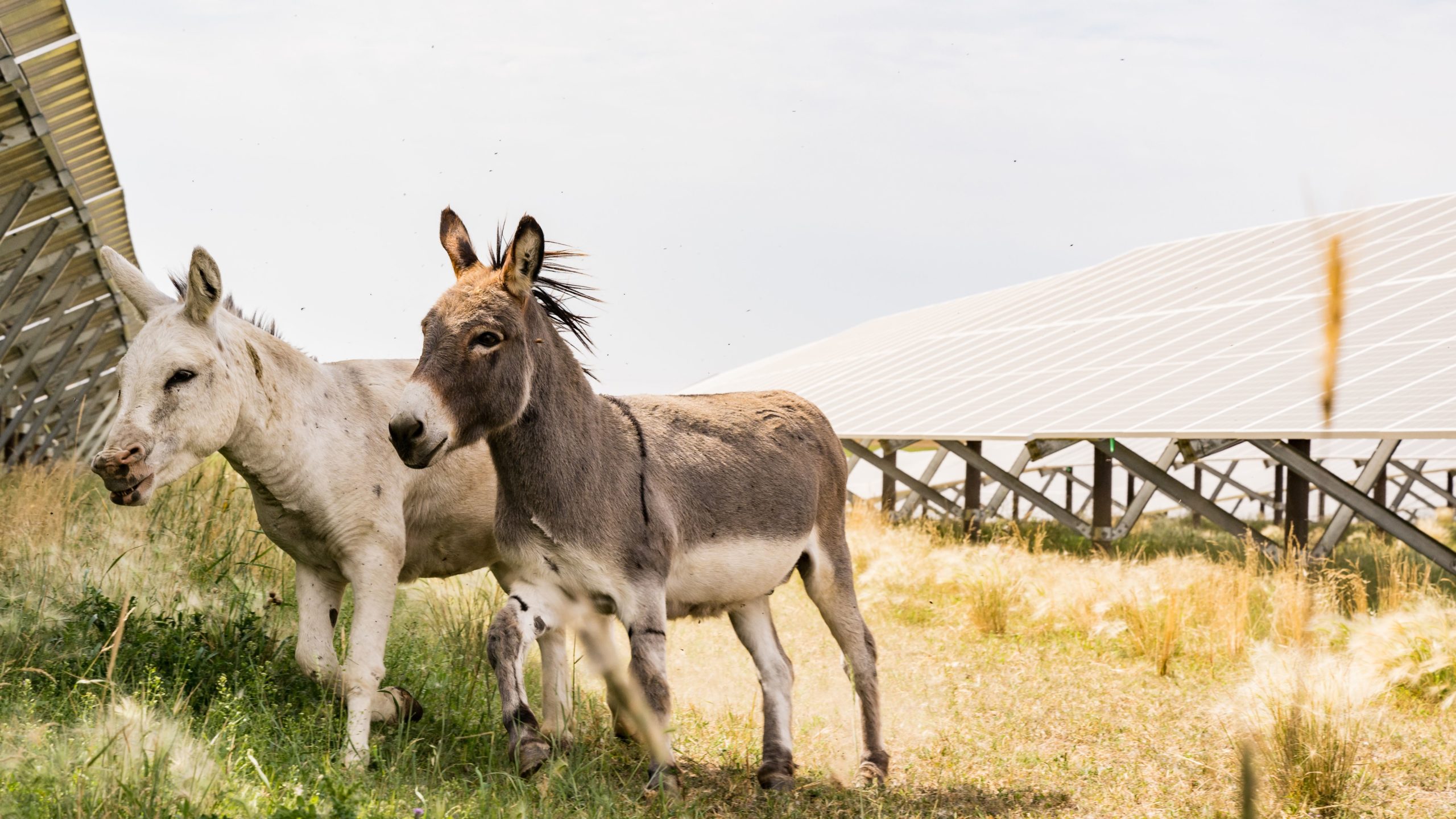
Sharing is caring – how multi-use land helps renewable developers and communities

The Burdett and Yellow Lake Solar Facility, a source of Bullfrog Power’s green electricity developed and operated by BluEarth Renewables, produces enough renewable energy to power about 6,400 homes. And that isn't all – these two solar farms are set on multi-use land that's home to 400 sheep and two miniature donkeys named Starsky and Hutch.
Bullfrog spoke with Kelly Matheson-King, Chief Operating Officer of BluEarth, to learn more about the benefits of sharing their solar arrays with four-legged friends. We also found out how they select renewable energy sites while balancing land use and community benefits.
Bullfrog Power: Why did BluEarth decide to keep sheep and donkeys at their solar facilities?
Kelly Matheson-King: The sheep at our solar facilities are a sustainable method of vegetation management. The animals ensure the ground cover doesn’t grow too tall and shade the panels, and they get sustainable feed in return. With this method, we require minimal specialized mowing equipment to maintain vegetation between panels, and it supports our ESG priorities.
The donkeys are on site to help protect the herd from potential threats, such as coyotes. Starsky and Hutch are miniature donkeys, so they can walk right under the panels without damaging them.
The animals have been so helpful that we’re looking to expand our use of sheep at our three other operating solar facilities in Alberta in the coming year.

Bullfrog: Highway 3, where the Burdett and Yellow Lake solar farms are located, has been called Alberta’s Energy Transition Corridor. What makes this area so attractive to wind and solar developers?
Kelly: This area is great for renewable energy for several reasons. Firstly, the area has a strong wind and solar resource, with southern Alberta being known as the “sunbelt of Canada.” The area also boasts lots of open space and landowners that want to be part of these projects, providing ideal locations for renewable energy leases. And thirdly, Alberta has a deregulated energy market which allows developers like BluEarth to sell power directly to commercial buyers such as Bullfrog, which has brought billions of dollars of investment to the province.
Bullfrog: There’s some concern that renewable energy projects take up valuable farmland or disrupt important ecological zones. Do you consider this when selecting sites?
Kelly: Existing land use is an important factor we consider when siting projects, in addition to the area’s resource, proximity to existing infrastructure, and willing landowners. We avoid sensitive environmental features such as native grasslands, threatened or endangered species, and critical habitat.
Solar facilities occupy the majority of land on which they are sited, so this is a key consideration for many landowners when determining how a solar facility might compliment their broader farming operation.
Wind turbines however occupy a small fraction of the land on which they are sited, so they work in harmony with existing and established land uses. Many of the activities that occurred on the land before a wind facility was built can continue undisturbed after construction is completed. For example, crops can be planted to the base of the turbines and harvested with typical farming equipment. Livestock, such as sheep, cows, and horses, can continue to graze around the towers.

Bullfrog: How do communities typically feel about your projects? Do you have strategies to gain community buy-in?
Kelly: In the planning and design of all our projects, BluEarth makes decisions based on consultation and collaboration with all our stakeholders. From the early siting of a project, through the regulatory process and construction and into operations, we work to forge long-term relationships and help build strong communities.
Projects such as the Yellow Lake & Burdett Solar Facility provide several benefits to the local community such as employment during construction and operations, ongoing contributions to the community’s tax base, annual donations to local charities and programs, and a significant capital investment in the local economy.
Bullfrog: Is BluEarth exploring other ways to combine renewable energy with different types of multi-use land?
Kelly: Each facility is unique, and various factors can influence what types of activities can take place on site. In Ontario, our team is working with a local beekeeping group to host honeybees on site which forage and pollinate the surrounding area. These facilities feature a mix of clover, wildflowers, and weeds as ground cover, providing ideal foraging options for the bees, which travel up to 9 km for pollination. We began this pilot program in 2021 with 11 hives in total, estimated to provide approximately 40–60 jars of honey per hive annually.
We also look at locations where we can build projects on brownfield sites, which provide a great opportunity to develop clean, renewable energy on land which may otherwise be unusable. In British Columbia, our team is currently involved in the development of a solar facility on a brownfield mining site.
Choose green electricity from sources including the Burdett and Yellow Lake Solar Facility

Green electricity
$37.50/month

Green electricity
$93.75/month
